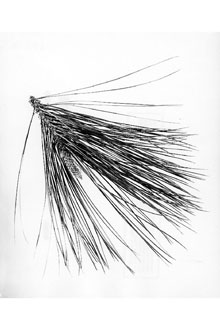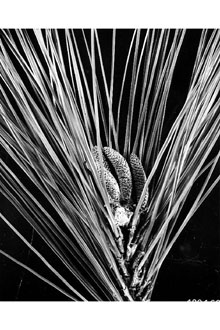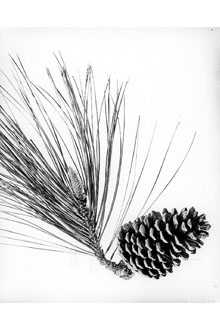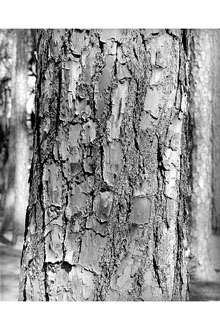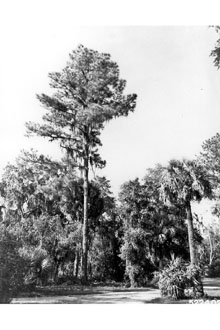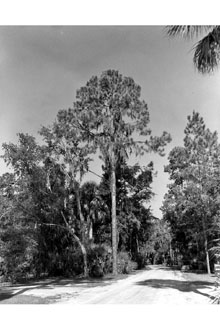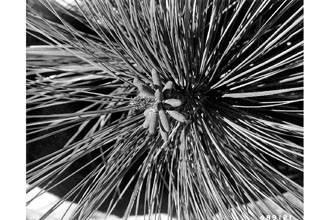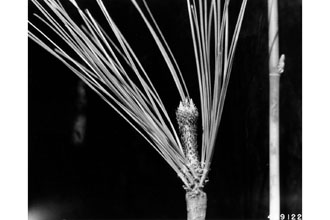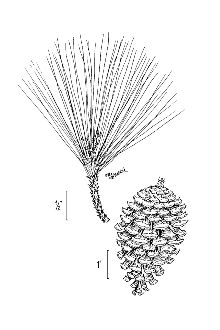Slash Pine
Scientific Name: Pinus elliottii Engelm.
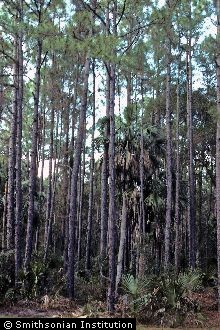
| General Information | |
|---|---|
| Usda Symbol | PIEL |
| Group | Gymnosperm |
| Life Cycle | Perennial |
| Growth Habits | Tree |
| Native Locations | PIEL |
Plant Guide
Uses
Commercial uses: Slash pine is used for reforestation projects and timber plantations throughout the southeastern United States. Its pines produced turpentine and crude rosins used for a variety of purpose (i.e., poles, railroad ties, pilings, turpentine, and rosin). Wildlife uses: The slash pine seeds are an excellent food source for gray and fox squirrels and wild turkey.
Status
Please consult the PLANTS Web site and your State Department of Natural Resources for this plant’s current status (e.g. threatened or endangered species, state noxious status, and wetland indicator values).
Description
General: Slash pine (Pinus elliottii) is one of the hard yellow pines indigenous to southeastern United States, The slash pine is a medium to large tree that reaches heights of 80' to 100' tall, It has a round top and "brooms" of needles at the ends of the branches, Its’ needles may be 5" to 11" long and are borne 2 to 3 to a fascicle, The orange-brown bark is scaly with plates, It is durable and hard, nearly equivalent to that of longleaf pine (Pinus palustrus), It has thick, plate-like bark with an extensive root system, and a moderate taproot, Its cones measure 8-16 cm (3 – 6 inches) long, and are a glossy brown color, And the cone scales are thin with fine prickles Pinus elliottii var, elliottii is found in the Coastal Plain of north and Central Florida, Whereas, the Southern slash pine or Pinus elliottii var,, Use soil moisture sensors to measure the soil moisture of Slash Pine., densa is found in South Florida, West Indies, Guatemala, and Honduras in Central America, The slash pine is commonly associated with the loblolly pine (Pinus taeda); however, the length and number of needles per fascicle, cones, and bark can be used to differentiate them, Distribution: The slash pine can be found on coastal plains throughout the Indian River Lagoon area, and in freshwater upland areas, It occurs on coastal plains from South Carolina to Central Florida, and west to Louisiana, The Pinus elliottii occurs from Central Florida through South Florida and the Florida Keys, Slash pine was introduced in Kentucky, Virginia and eastern Texas in the 1900's, and now reproduces naturally within these states, Habitat: The climate within the natural range of slash pine is warm and humid, and it likes wet summers, drier falls and springs, It grows well with rainfall averages about 1270 mm (50 in) per year, and summer rains of 13 mm (0,5 in) or more occur about four times per month, The mean annual temperature in the slash pine region is 17° C (63° F), with extremes of 41° C (106° F) and -18° C (0° F), and a growing season of 250 days, The slash Pine grows well on a variety of acidic soils in full sun or partial shade, It does poorly in basic soil (high pH) and is not recommended for irrigation water has a high pH, Once established, it is more tolerant of wet sites than most other pines and is moderately salt-tolerant, It is not highly drought-tolerant, but more so than most other pines, The horizontal branches break easily in ice storms, It is not recommended to plant the tree too close to high traffic areas, since shaded lower branches, die and drop, as the tree grows taller, This is dangerous because branches could fall on people or vehicles, unless there is a regular maintenance plan to remove them,
Adaptation
The slash pine grows in the infertile soils of sandhills, flatwoods, and near wet lowlands, such as swamps and ponds. Soils within its range are mostly Spodosols, Ultisols, and Entisols. Spodosols, Entisols are common along the coasts of Florida while the Ultisols are in the northern part of the range. Originally, slash pines were found in moist, well-drained aerated soils, of the southeastern United States, particularly along pond, stream, and lake margins. This habitat preference is a reflection of the susceptibility of the seedlings to fire, with the advent of fire protection, slash pine has spread to drier soils in the southeast and Texas. Although slash pine is adaptable to a variety of site and topographic conditions, it grows best on pond margins and in drainages where soil moisture is ample but not excessive and the soil is well aerated.
Establishment
The slash pines are monoecious, and often hybridize with other pines such as loblolly pine (P. taeda), sand pine (P. clausa) and longleaf pine (P. palustris). They begin producing cones at approximately 10-15 years of age. The typical variety produces good cone crops every 3 years, while the south Florida variety produce good cone crops every 4 years. It has been estimated that 90% of the winged seeds from slash pines fall within 46 m (150 feet) of the parent tree. The male strobili begin to develop in June, and grow for several weeks. It enters a dormant state until midwinter. Pollen is shed from January through February. The female strobili develop in late August and cones mature in September, approximately 20 months after being pollinated. Natural seed fall occurs from October to March. The germination occurs within two weeks following seedfall. The slash pine seedlings in their first year are grass-like in appearance. Seedlings can have a year grass stage similar to that of longleaf pines (P. palustris). Grass-stage seedlings develop extensive root systems and root collars (Harlow et al. 1979). Root development in influenced by soil texture and structure, clay and clay loam soils produce larger roots than does sandy soil. Soils with a high presence of mycorrhizae have a positive influence on seedling root development and survival. Growth is rapid in the first year, with seedlings reaching heights of approximately 41 cm (16 inches). Slash pine grown for commercial production is generally established in plantations using genetically improved planting stock. Sites selected for planting are usually site prepared by flat disking, chopping, or bedding. Disking and chopping are effective on dry sandy soils where control of competing vegetation is a problem and one is trying to reduce the use of chemical application for competition control. However, on sites with a shallow water table bedding will increase rooting space, aeration and increase seedling survival and growth. On droughty sites, bedding can be used if the site is irrigated and vegetation is controlled. These treatments are the standard for contemporary slash pine plantation management. Control of weeds, woody shrub, and herbaceous species is a vital part of increased slash pine plantation productivity. Plantation establishment from seedling is usually with 1-2 year old bare root seedlings or container seedlings. When out planting seedling by hand or machine care must be taken to insure that the roots are planted straight down to, avoid seedling mortality. Because many slash pine site are low in available phosphorus and nitrogen each site should be soil tested to determine the amount of nitrogen and phosphorus needed to ensure seedling survival and volume growth
Pests and Potential Problems
Fusiform rust (Cronartium quercuum f. sp. fusiforme), annosus root rot (Heterobasidion annosum), and Fusarium moniliforme var subglutinans are the most serious pest of slash pines Fusiform rust, an obligate parasite requiring two living host trees pine and oak leaves to complete its life cycle. The fungus cannot spread from pine to pine, but must return to the oak leaves to produce the spores that in turn infect pine. The disease which develops at or near the point of infection, result in tapered, spindle-shaped swells, called galls, on branches and stems of pines. Annosus root rot is a fungal disease that infects freshly cut stumps of slash pine, and spreads to other trees by root contact. Diseased or dead and dying trees are usually found in groups. The slash pines can be damaged by insects pests such as the pales weevil (Hylobius pales), that invades
Plant Traits
Growth Requirements
| Temperature, Minimum (°F) | -18 |
|---|---|
| Adapted to Coarse Textured Soils | No |
| Adapted to Fine Textured Soils | Yes |
| Adapted to Medium Textured Soils | Yes |
| Anaerobic Tolerance | Low |
| CaCO3 Tolerance | Low |
| Cold Stratification Required | Yes |
| Drought Tolerance | Low |
| Fertility Requirement | Low |
| Fire Tolerance | Low |
| Frost Free Days, Minimum | 250 |
| Hedge Tolerance | None |
| Moisture Use | Medium |
| pH, Maximum | 6.4 |
| pH, Minimum | 4.0 |
| Planting Density per Acre, Maxim | 1200 |
| Planting Density per Acre, Minim | 430 |
| Precipitation, Maximum | 80 |
| Precipitation, Minimum | 40 |
| Root Depth, Minimum (inches) | 40 |
| Salinity Tolerance | None |
| Shade Tolerance | Intolerant |
Morphology/Physiology
| Bloat | None |
|---|---|
| Toxicity | None |
| Resprout Ability | No |
| Shape and Orientation | Erect |
| Active Growth Period | Spring and Summer |
| C:N Ratio | High |
| Coppice Potential | No |
| Fall Conspicuous | No |
| Fire Resistant | Yes |
| Flower Color | Red |
| Flower Conspicuous | No |
| Foliage Color | Dark Green |
| Foliage Porosity Summer | Moderate |
| Foliage Porosity Winter | Moderate |
| Foliage Texture | Fine |
| Fruit/Seed Conspicuous | Yes |
| Nitrogen Fixation | None |
| Low Growing Grass | No |
| Lifespan | Long |
| Leaf Retention | Yes |
| Known Allelopath | No |
| Height, Mature (feet) | 100.0 |
| Height at 20 Years, Maximum (fee | 60 |
| Growth Rate | Rapid |
| Growth Form | Single Stem |
| Fruit/Seed Color | Brown |
Reproduction
| Vegetative Spread Rate | None |
|---|---|
| Small Grain | No |
| Seedling Vigor | High |
| Seed Spread Rate | Slow |
| Fruit/Seed Period End | Fall |
| Seed per Pound | 14480 |
| Propagated by Tubers | No |
| Propagated by Sprigs | No |
| Propagated by Sod | No |
| Propagated by Seed | Yes |
| Propagated by Corm | No |
| Propagated by Container | Yes |
| Propagated by Bulb | No |
| Propagated by Bare Root | Yes |
| Fruit/Seed Persistence | Yes |
| Fruit/Seed Period Begin | Summer |
| Fruit/Seed Abundance | Medium |
| Commercial Availability | Routinely Available |
| Bloom Period | Winter |
| Propagated by Cuttings | No |
Suitability/Use
| Veneer Product | Yes |
|---|---|
| Pulpwood Product | Yes |
| Post Product | Yes |
| Palatable Human | No |
| Palatable Graze Animal | Low |
| Palatable Browse Animal | Low |
| Nursery Stock Product | Yes |
| Naval Store Product | Yes |
| Lumber Product | Yes |
| Fuelwood Product | Low |
| Fodder Product | No |
| Christmas Tree Product | No |
| Berry/Nut/Seed Product | No |

